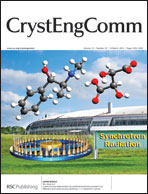Four new d10 metal–organic coordination polymers tuned by the “V”-shaped tri-pyridyl–bis-amide ligands with different spacers, namely, [Zn(L1)(BDC)]·H2O (1), [Cd(L1)(BDC)]·H2O (2), [Zn(L2)(BDC)] (3) and [Cd(L2)(BDC)] (4) (L1 = N,N′-bis(pyridine-3-yl)pyridine-2,6-dicarboxamide, L2 = N,N′-bis(pyridine-3-yl)pyridine-3,5-dicarboxamide, H2BDC = 1,4-benzenedicarboxylic acid) have been synthesized under hydrothermal conditions. In complexes 1 and 2, the metal ions are linked by L1 to form left- and right-helical Zn/Cd–L1 chains, which are further extended into two-dimensional (2D) wave-like layers by BDC anions. In 3, two L2 ligands link two ZnII ions forming the Zn2(L2)2 loops, which are connected by BDC anions to form a (2·65) topological 2D network. In addition, the large Zn2(L2)2 loops are threaded by the BDC rods from above and below 2D layers so as to form 2D → 3D polyrotaxane and polycatenane structures. In 4, the CdII ions are linked by L2 ligands to generate 1D double chain ribbons with Cd2(L2)2 loops, which are further connected by the BDC linkers to form a 3D framework. Two identical 3D frameworks interpenetrate each other in a twofold mode, giving rise to a polyrotaxane and polycatenane array, which is relative limited. The diverse structures of complexes 1–4 demonstrate that the tri-pyridyl–bis-amide ligands and the central metals have significant effect on the final structures. The thermal stability and fluorescent properties of complexes 1–4 have been investigated. In addition, the title complexes exhibit photocatalytic activity for dye methylene blue degradation under UV light.


 Please wait while we load your content...
Please wait while we load your content...